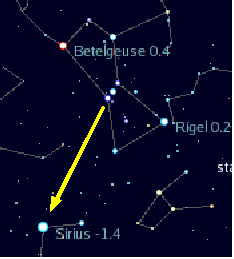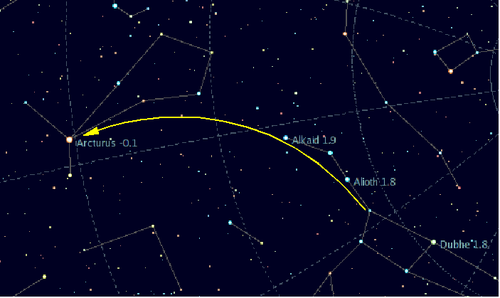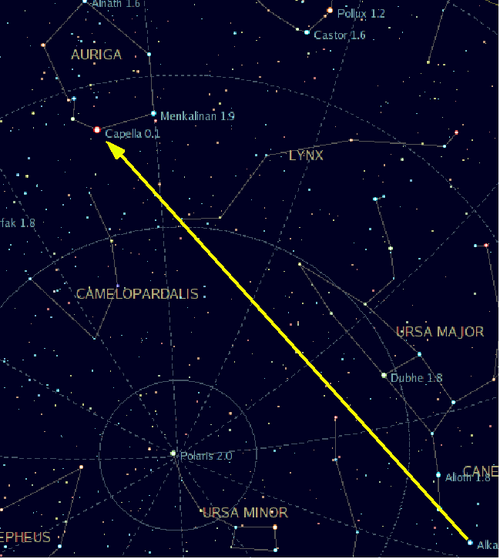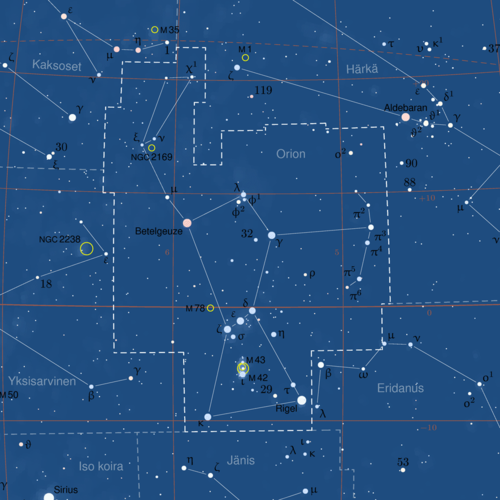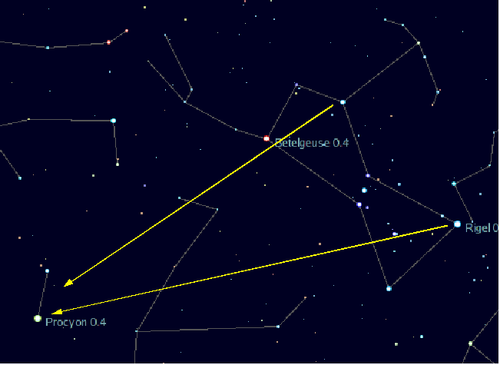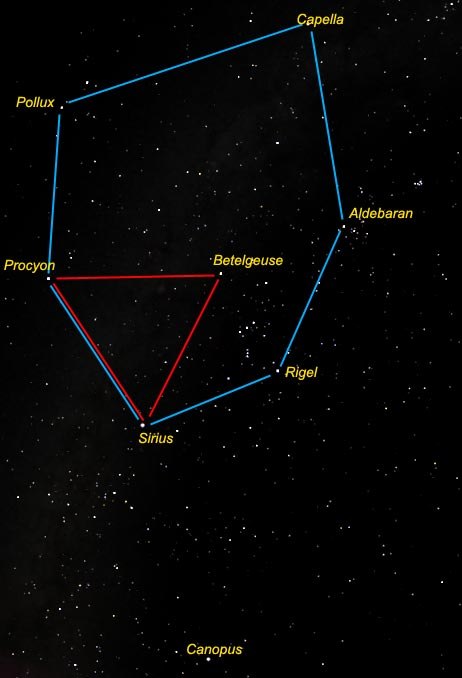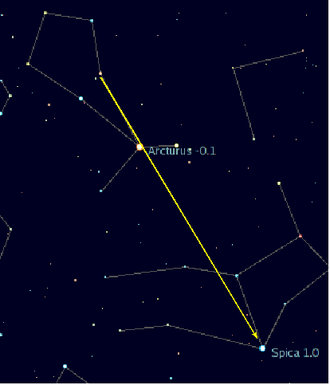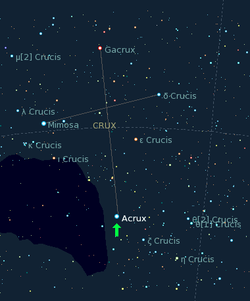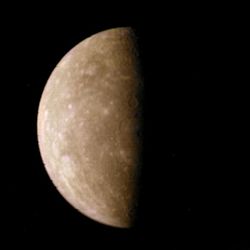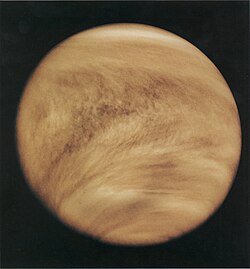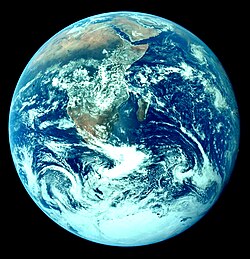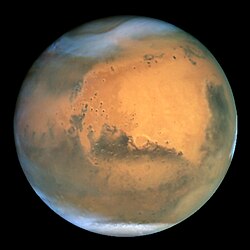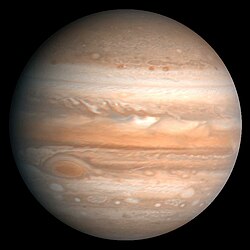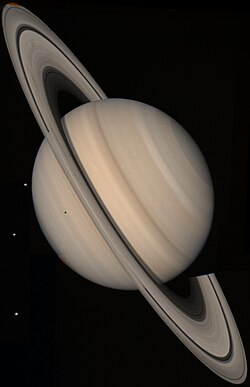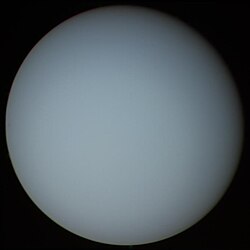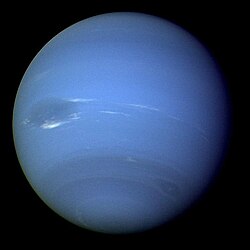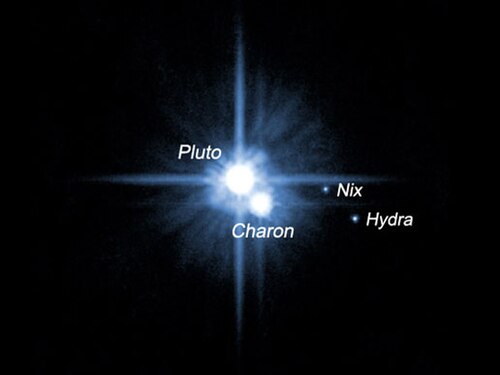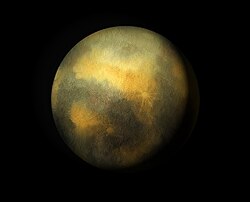AY Honors/Stars - Advanced/Answer Key 2
Like many honors, the requirements for Stars - Advanced differ from one division to the next. The North American Division's version is presented here, and you can follow the link below to the General Conference version.
1. Have the Star Honor.
Answers for the Stars honor can be found in the Nature chapter of this wikibook.
2. How can you account for the apparent daily motion of the stars?
Template:Ay stars adv daily motion
3. What are each of the following. Identify personally or from pictures an example of each.
a. Planet
b. Satellite
Template:Ay stars adv satellite
c. Comet
d. Meteor
e. Meteorite
A meteorite is an extraterrestrial body that survives its impact with the Earth's surface without being destroyed. While in space it is called a meteoroid. When it enters the atmosphere, air resistance causes the body to heat up and emit light, thus forming a fireball, also known as a meteor or shooting star.
More generally, a meteorite on a celestial body is an object that has come from elsewhere in space.
Most meteoroids disintegrate when entering the Earth's atmosphere, however an estimated 500 meteorites ranging in size from marbles to basketballs or larger do reach the surface each year; only 5 or 6 of these are typically recovered and made known to scientists. Few meteorites are large enough to create impact craters. Instead, they typically arrive at the surface at their terminal velocity (free-fall) and, at most, create a small pit. Even so, falling meteorites have caused damage to property, livestock, and even people in historic times.
f. Nebula
g. Constellation
Template:Ay stars adv constellation
h. Fixed star
Template:Ay stars adv fixed star
i. Sunspot
4. Define the following terms:
5. Explain the major difference between a refractor and reflector type of telescope. Describe an equatorial telescope mounting.
Template:Ay stars adv telescope
6. Into what colors is sunlight dispersed when passed through a prism? In what way are colors of stars used to indicate their temperature?
7. What connection is there between the ecliptic and the vernal and autumnal equinoxes? What dates are usually associated with the equinoxes?
8. Learn the 12 constellations called the signs of the zodiac. Know the history of the signs of the zodiac.
By 2,000 BC, the Egyptians and Mesopatamians marked the seasons by the constellations we now call Taurus, Leo, Scropio and Aquarius. The division of the ecliptic into the zodiacal signs originates in Babylonian ("Chaldean") astronomy in the early to mid 1st millennium BC (likely during Median/"Neo-Babylonian" times).
The signs were named after the nearby constellations at the time of Ptolemy, most of which were named after animals, hence the term zodiac (from Greek zodiakos, "circle of little animals").
- ♈ Aries 0° (vernal equinox)
- ♉ Taurus 30°
- ♊ Gemini 60°
- ♋ Cancer 90° (summer solstice)
- ♌ Leo 120°
- ♍ Virgo 150°
- ♎ Libra 180° (autumnal equinox)
- ♏ Scorpius 210°
- ♐ Sagittarius 240°
- ♑ Capricornus 270° (winter solstice)
- ♒ Aquarius 300°
- ♓ Pisces 330°
9. Identify by their name and point out in the sky the constellations that can be seen all night long on a clear night in your hemisphere.
The constellations that can be seen all night in each hemisphere are the ones near the celestial poles.
Northern Hemispere:
- Ursa Minor
- Ursa Major
- Draco
- Cepheus
Southern Hemisphere:
- Octans
- Mensa
- Hydrus
- Chameleon
- Volans
- Pavo
- Musca
10. Name five constellations that are visible between sunset and midnight in your hemisphere during:
a. The summer months.
Northern Hemisphere: In the east you should be able to find Cygnus (the Northern Cross) and Aquila. Directly overhead you should see Lyra. To the west you should be able to find Virgo, Leo, and Bootes.
Southern Hemisphere: In the east you should be able to find Aquila, Capricorn, and Sagitarius. Directly overhead you should see Scorpius. To the southwest you should be able to find Crux (the Southern Cross) and Centaurus.
b. The winter months.
Northern Hemisphere: To the south you should be able to see Orion, Canis Major, Canis Minor, Gemini, and Auriga.
Southern Hemisphere: In the east you should be able to find Canis Major, and Canis Minor. In the north you should see Orion. To the west you should be able to find Cetus and Fornax.
11. At what time of year is the constellation Orion best seen? Locate and identify in the sky the three brightest stars of this constellation.
Orion is best seen in the winter because it is then visible just after sunset, and throughout most of the night. In the Northern Hemisphere the winter sky is generally clearer than the summer sky. The three brightest stars in Orion are Rigel (right foot), Betelguese (left shoulder), and Bellatrix (right shoulder).
12. How are the letters of the Greek alphabet used to name stars in a constellation? Give five illustrations of the use of the letters of the Greek alphabet in naming the stars of a constellation.
The brightest star in a constellation is called alpha plus the constellation name. The second brightest is named beta, the third brightest is named gamma, and so forth. The best known example of this is Alpha Centauri which is the brightest star in the constellation Centaur. However, Alpha Centauri is actually a binary star, so the first two stars in our list can be Alpha Centauri A, and Alpha Centauri B. Acrux, Becrux, and Gacrux are the three brightest stars in Crux, the Southern Cross, and are so named as an abreviation of Alpha-Crux, Beta-Crux, and Gamma-Crux.
13. Locate the 15 first-magnitude stars as they appear throughout the year.
This requirement cannot be met as it is written unless the Pathfinder is lucky enough to be able to travel to both the Northern and Southern Hemispheres or into the tropics. Many Southern Hemisphere stars are visible south of the Tropic of Cancer, so if you happen to be planning a vacation (or a mission trip) to the Virgin Islands, look for the five first magnitude stars in the Southern Hemisphere.
First-magnitude stars in the Northern Hemisphere
Sirius
Sirius is the brightest star in the night-time sky, with a visual apparent magnitude of −1.46. It is located in the constellation Canis Major. As the major star of the "Big Dog" constellation, it is often called the "Dog Star". Sirius can be seen from every inhabited region of the Earth's surface. At a distance of 2.6 pc or 8.57 light years, Sirius is also one of the nearest stars to Earth. The best time of year to view it is around January 1, when it reaches the meridian at midnight. Sirius can be found by following Orion's belt from the viewer's right to left.
Arcturus
Arcturus is the brightest star in the constellation Boötes, and the third brightest star in the night sky, with a visual magnitude of −0.05, after Sirius and Canopus. Arcturus can be found by following the arc made by handle of the Big Dipper (away from the dipper's bowl).
Vega and Altair
Vega is the brightest star in Lyra, and the fifth brightest star in the sky. It is the third brightest star in the Northern night sky, after Sirius and Arcturus, and can often be seen near the zenith in the mid-northern latitudes during the Northern Hemisphere summer.
Vega is a vertex of the Summer Triangle, which consists of Vega (in Lyra), Deneb (in Cygnus) and Altair (in Aquila). If one is to consider this asterism a right triangle, then Vega would correspond to its right angle. This triangle is very recognisable in the northern skies for there are few bright stars in its vicinity.
Altair is the brightest star in the constellation Aquila and the twelfth brightest star in the nighttime sky, at visual magnitude 0.77. Like Vega, it is a member of the Summer Triangle.
Capella
Capella is the brightest star in the constellation Auriga and sixth brightest star in the sky. Although it appears as a single point to the naked eye, Capella is actually a bright close binary pair of stars along side a second, fainter binary. Capella can be found by following the line made by the two stars in the Big Dipper's handle and extending it across the Dipper's bowl.
Rigel and Betelguese
Rigel is the brightest star in the constellation Orion and the seventh brightest star in the sky, with visual magnitude 0.12. Rigel is Orion's left foot.
Betelguese is the second brightest star in the constellation Orion, and the tenth brightest star in the night sky. Betelguese is Orion's right shoulder. Betelgeuse is a red supergiant, one of the physically largest stars known. If it were placed at the center of our solar system, its outer surface would possibly extend to the orbit of Mars.
Procyon
Procyon is the brightest star in the constellation Canis Minor and the eighth brightest star in the nighttime sky. It can be found using stars in Orion in two different ways:
- By following Orion's left foot (Rigel) through the tip of his sword.
- By following Bellatrix (his left shoulder) through Betelguese (his right shoulder).
Procyon, Sirius, and Betelguese also form an equilateral triangle.
Aldebaran
Once you can find Rigel, Sirius, Procyon, and Capella, finding Aldebaran is easy, for these five stars, plus Pollux make up the Winter Circle.
Spica
Spica is the brightest star in the constellation Virgo, and the 15th brightest star in the sky. It can be found by following a line starting at the star ρ Boötis, and continuing through Arcturus to Spica.
First-magnitude stars in the Southern Hemisphere
Canopus
Canopus is the brightest star in the southern constellation of Carina, and the second brightest star in the sky, with a visual magnitude of −0.62, second only to Sirius. Canopus is a yellowish-white supergiant star. It is located well into the southern hemisphere, at a declination of −52° 42' (2000) and a right ascension of 06h24.0m, and is visible on the southern horizon of even the southern US States as far north as Virginia or Kentucky. That far north, it can only be seen on a very clear night during the last two weeks of February directly south very low on the horizon just after sunset.
Alpha Centauri A and Hadar
Alpha Centauri A is located in the Southern Hemisphere, and can only be seen in the United States from points south of Daytona Beach, Florida or San Antonio, Texas. Even then, it barely rises above the horizon directly to the South for a few days around July 8.
Hadar is also known as Beta Centauri, for it is the second brightest star in the constellation Centaurus. It is just to the West of Alpha Centauri A, so if you can see the one, you can probably see the other.
Achernar
Achernar is located in the Southern Hemisphere, and therefore is never visible in most of North America. It can be seen from Dallas Texas and points south in mid to late November due South, and very low on the horizon.
Acrux
Acrux is the brightest star in constellation Crux (the Southern Cross) and the thirteenth brightest star in the nighttime sky, at visual magnitude 0.77. Acrux is represented in the flag of Australia as one of the 5 stars that comprise the Southern Cross. Since Acrux is at roughly −60° declination, it is generally only visible south of the Tropic of Cancer and therefore didn't receive an ancient traditional name; "Acrux" is simply a combination of the A in Alpha plus Crux (meaning "cross"). Acrux is the southernmost first magnitude star, just a bit more southerly than Alpha Centauri. Acrux can be seen as far north as Miami, Florida, but it only barely rises above the horizon. You might be able to see it due south around May 8 (any year) at about 9:00 pm. If you wait around until midnight, Alpha Centauri and Hadar will also be visible around that date as well (also directly to the south and just over the horizon).
14. With the use of a diagram, show the relative positions of the earth and moon during high and low tides.

Since the Earth's crust is solid, it moves, along with everything inside it, as one whole, as defined by the average force on it. For the Earth's shape this average force is equal to the force on its center. The water at the surface is free to move following forces on its particles. One of the forces that affects tides is the gravity of the Moon. The force of gravity gets weaker as the distance between two bodies increases, and since the center of the Earth is farther away than the surface nearest the Moon, the Moon's gravity pulls on the surface water stronger than it pulls on the whole of the Earth. This causes the water level to rise and causes a high tide.
Meanwhile, on the side of the Earth opposite the Moon, the surface is farther from the moon than the Earth's center, so the Moon pulls more strongly on the Earth as a whole than it does on the water. This causes the water move away from the Moon, but since this is on the other side of the Earth, the water level still rises, causing a high tide.
Low tides occur at the points on the Earth where the Moon is just rising or just setting - that is, where the surface is at a 90° angle from the moon.
The Sun also has a tidal effect, but since it is much farther away, the difference between the pull of gravity at the surface of the Earth and the pull of gravity at the center is much smaller as compared to the Moon. When the tidal action caused by the Sun and Moon reinforce one another we have a spring tide (which is higher than normal). When they oppose one another, we have a neap tide (which is also a high tide, but lower than normal).
15. Describe the peculiar individual characteristics of the planets in our solar system. Which ones cannot be seen without the aid of a telescope? Which two planets are seen only near the hours of sunrise or sunset?
Uranus, Neptune, Pluto, and 2003 UB313 cannot be seen with the naked eye. Mercury and Venus are only seen near the hours of sunrise and sunset because they are both closer to the Sun than the Earth.
Mercury
Mercury is the planet closest to the Sun. It orbits the Sun once every 88 Earth-days. Mercury has very little atmosphere because its gravity is so weak due to its small size. Like the Moon, Mercury's lack of an atmosphere means that it is struck often by other bodies, leaving its surface cratered. If it had a thicker atmosphere, these objects would burn up before they reached the surface. Another similarity between Mercury and the Moon is that Mercury's day is equal to its year at 88 days.
Venus
Venus is the second-closest planet to the Sun, orbiting it every 224.7 Earth days. After Earth's Moon, it is the brightest object in the night sky. Venus is one of the four terrestrial planets, meaning that, like the Earth, it is a rocky body. In size and mass, it is very similar to the Earth, and is often described as its 'twin'. The diameter of Venus is only 650 km less than the Earth's, and its mass is 80% of the Earth's. However, conditions on the Venusian surface differ radically from those on Earth, due to its dense carbon dioxide atmosphere. The enormously CO2-rich atmosphere generates a strong greenhouse effect that raises the surface temperature to over 400 °C. This makes Venus' surface hotter than Mercury's, even though Venus is nearly twice as distant from the Sun and receives only 25% of the solar irradiance.
Earth
Earth is the only planet in the Solar System that supports life. Its atmosphere protects the Earth's life forms by absorbing ultraviolet solar radiation, moderating temperature extremes, transporting water vapor, and providing useful gases. The atmosphere is also one of the principle components in determining the weather and climate of the Earth.
Mars
Mars is the fourth planet from the Sun in our solar system. Mars is also known as "The Red Planet" due to the reddish appearance it has when seen from Earth at night. Mars has two moons, Phobos and Deimos, which are small and oddly-shaped and are possibly captured asteroids. Until the first flyby of Mars by Mariner 4 in 1965, it was thought that Mars had channels of liquid water. We now know that these channels do not exist. Still, of any planet in our solar system after the Earth, Mars is the most likely to harbor liquid water. It is the only planet besides Earth that has seasons. It also has a rotational period nearly the same as our own. It has the highest mountain in the solar system, Olympus Mons, the largest canyon in the solar system, Valles Marineris, and polar ice caps.
Jupiter
Jupiter is the fifth planet from the Sun and by far the largest within the solar system. Jupiter is usually the fourth brightest object in the sky (after the Sun, the Moon and Venus); however at times Mars appears brighter than Jupiter. Jupiter is 2.5 times more massive than all the other planets combined. Jupiter also has the fastest rotation rate of any planet within the solar system, making a complete rotation on its axis in slightly less than ten hours, which results in an equatorial bulge easily seen through an Earth-based amateur telescope. Jupiter is perpetually covered with a layer of clouds, and it may not have any solid surface in that the density may simply increase gradually as you move towards the core. Its best known feature is the Great Red Spot, a storm larger than Earth.
Saturn
Saturn is the sixth planet from the Sun. It is a gas giant (also known as a Jovian planet, after the planet Jupiter), the second-largest planet in the solar system after Jupiter. Saturn is probably best known for its planetary rings, which make it one of the most visually remarkable objects in the solar system. Saturn is the only one of the Solar System's planets less dense than water, with an average specific density of 0.69. This means that Saturn would float if you had a large enough body of water to place it in. Like Jupiter, it radiates more energy into space than it receives from the Sun.
Saturn has a large number of moons. The precise figure is uncertain as the orbiting chunks of ice in Saturn's rings are all technically moons, and it is difficult to draw a distinction between a large ring particle and a tiny moon. Seven of the moons are massive enough to have collapsed into a spheroid under their own gravitation. Saturn's most noteworthy moon is Titan, the only moon in the solar system to have a dense atmosphere.
Uranus
Uranus is the seventh planet from the Sun. It is a gas giant, the third largest by diameter and fourth largest by mass. Uranus is composed primarily of gas and various ices. The atmosphere is about 85% hydrogen, 15% helium and traces of methane, while the interior is richer in heavier elements, most likely compounds of oxygen, carbon, and nitrogen, as well as rocky materials. This is in contrast to Jupiter and Saturn which are mostly hydrogen and helium. One of the most distinctive features of Uranus is its axial tilt of ninety-eight degrees. Consequently, for part of its orbit one pole faces the Sun continually while the other pole faces away. At the other side of Uranus' orbit the orientation of the poles towards the Sun is reversed. Between these two extremes of its orbit the Sun rises and sets around the equator normally.
Neptune
Neptune is the outermost gas giant in our solar system. For most of its 165 year orbit it is the eighth planet from the Sun and occasionally the ninth due to Pluto's eccentricity. It is the fourth largest planet by diameter and the third largest by mass; Neptune is more massive than its near twin Uranus as its stronger gravitational field has compressed it to a higher density. Neptune's atmosphere is primarily composed of hydrogen and helium, with traces of methane that account for the planet's blue appearance. Neptune also has the strongest winds of any planet in the solar system, with estimates as high as 1550 MPH (2,500 km/h). Discovered on September 23, 1846, Neptune is notable for being the only planet discovered based on mathematical prediction rather than regular observations. Perturbations in the orbit of Uranus led astronomers to deduce Neptune's existence. One difference between Neptune and Uranus is the level of meteorological activity. Uranus is visually quite bland, while Neptune's high winds come with notable weather phenomena. The Great Dark Spot, a cyclonic storm system the size of Asia, was captured by Voyager 2 in the 1989 flyby. The storm resembled the Great Red Spot of Jupiter, but was shown to have disappeared in June 1994. However, a newer image of the planet taken by the Hubble Space Telescope on November 2, 1994, revealed that a smaller storm similar to its predecessor had formed over Neptune’s Northern Hemisphere. Unique among the gas giants is the presence of high clouds casting shadows on the opaque cloud deck below.
Pluto
Pluto is the ninth and smallest of the traditional planets of the Solar system, though its status as a planet has been disputed in recent years. It has an eccentric orbit that is highly inclined with respect to the other planets and takes it closer to the Sun than Neptune during a portion of its orbit. It is also the smallest planet and indeed is smaller than several moons of other planets. Pluto itself has a large moon named Charon; two small moons were discovered in 2005, and their names (Hydra and Nix) were announced in June 2006.
2003 UB313
2003 UB313 is a trans-Neptunian object (TNO) larger than the planet Pluto. It has been described as our solar system's tenth planet by its Mount Palomar-based discovery team, NASA, and some media outlets. The International Astronomical Union (IAU) is scheduled to publish the definition of the term "planet" in early September 2006, which will determine whether or not 2003 UB313 is classified as a planet. Its discoverer, Michael E. Brown, has given it the unofficial name "Xena".
2003 UB313 has an orbital period of 557 years, and currently lies at almost its maximum possible distance from the Sun (aphelion). It is currently the most distant known solar system object from the Sun at a distance of 97 astronomical units.
During 2005, the adaptive optics team at the Keck telescopes in Hawaii carried out observations of 2003 UB313, using the newly commissioned laser guide star adaptive optics system. Observations revealed a moon in orbit around 2003 UB313, provisionally designated S/2005 (2003 UB313). In keeping with the "Xena" nickname already in use for 2003 UB313, the moon was nicknamed Gabrielle by its discoverers, after the television warrior princess's sidekick. As with the "Xena" name, this is purely informal and it is expected another official name will be chosen for the moon, depending upon the final decided status of 2003 UB313.
16. Where and in what way does the Bible refer to Orion, the Pleiades, and Arcturus?
- Job 9:9 (21st Century King James Version)
- "Who maketh Arcturus, Orion and Pleiades, and the chambers of the south;"
- Job 38:31,32 (21st Century King James Version)
- "Canst thou bind the sweet influences of Pleiades, or loose the bands of Orion? Canst thou bring forth Mazzaroth in his season? Or canst thou guide Arcturus with his sons?"
- Amos 5:8 (NIV)
- "He who made the Pleiades and Orion, who turns blackness into dawn and darkens day into night, who calls for the waters of the sea and pours them out over the face of the land— the LORD is his name."
Most English versions of the Bible translate Arcturus as The Bear.
References
- Wikipedia articles:

